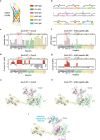Dual client binding sites in the ATP-independent chaperone SurA
- PMID: 39277579
- PMCID: PMC11401910
- DOI: 10.1038/s41467-024-52021-1
Dual client binding sites in the ATP-independent chaperone SurA
Abstract
The ATP-independent chaperone SurA protects unfolded outer membrane proteins (OMPs) from aggregation in the periplasm of Gram-negative bacteria, and delivers them to the β-barrel assembly machinery (BAM) for folding into the outer membrane (OM). Precisely how SurA recognises and binds its different OMP clients remains unclear. Escherichia coli SurA comprises three domains: a core and two PPIase domains (P1 and P2). Here, by combining methyl-TROSY NMR, single-molecule Förster resonance energy transfer (smFRET), and bioinformatics analyses we show that SurA client binding is mediated by two binding hotspots in the core and P1 domains. These interactions are driven by aromatic-rich motifs in the client proteins, leading to SurA core/P1 domain rearrangements and expansion of clients from collapsed, non-native states. We demonstrate that the core domain is key to OMP expansion by SurA, and uncover a role for SurA PPIase domains in limiting the extent of expansion. The results reveal insights into SurA-OMP recognition and the mechanism of activation for an ATP-independent chaperone, and suggest a route to targeting the functions of a chaperone key to bacterial virulence and OM integrity.
© 2024. The Author(s).
Conflict of interest statement
The authors declare no competing interests.
Figures






Similar articles
-
Outer membrane protein assembly mediated by BAM-SurA complexes.Nat Commun. 2024 Sep 1;15(1):7612. doi: 10.1038/s41467-024-51358-x. Nat Commun. 2024. PMID: 39218969 Free PMC article.
-
Dynamic interplay between the periplasmic chaperone SurA and the BAM complex in outer membrane protein folding.Commun Biol. 2022 Jun 8;5(1):560. doi: 10.1038/s42003-022-03502-w. Commun Biol. 2022. PMID: 35676411 Free PMC article.
-
Inter-domain dynamics in the chaperone SurA and multi-site binding to its outer membrane protein clients.Nat Commun. 2020 May 1;11(1):2155. doi: 10.1038/s41467-020-15702-1. Nat Commun. 2020. PMID: 32358557 Free PMC article.
-
The role of SurA factor in outer membrane protein transport and virulence.Int J Med Microbiol. 2010 Nov;300(7):421-8. doi: 10.1016/j.ijmm.2010.04.012. Epub 2010 May 6. Int J Med Microbiol. 2010. PMID: 20447864 Review.
-
SurA-like and Skp-like Proteins as Important Virulence Determinants of the Gram Negative Bacterial Pathogens.Int J Mol Sci. 2022 Dec 24;24(1):295. doi: 10.3390/ijms24010295. Int J Mol Sci. 2022. PMID: 36613738 Free PMC article. Review.
Cited by
-
Design and characterisation of photoactivatable and lysine reactive o-nitrobenzyl alcohol-based crosslinkers.Chem Sci. 2025 Jul 16. doi: 10.1039/d5sc03211c. Online ahead of print. Chem Sci. 2025. PMID: 40735685 Free PMC article.
References
Publication types
MeSH terms
Substances
Grants and funding
LinkOut - more resources
Full Text Sources
Molecular Biology Databases
Miscellaneous

